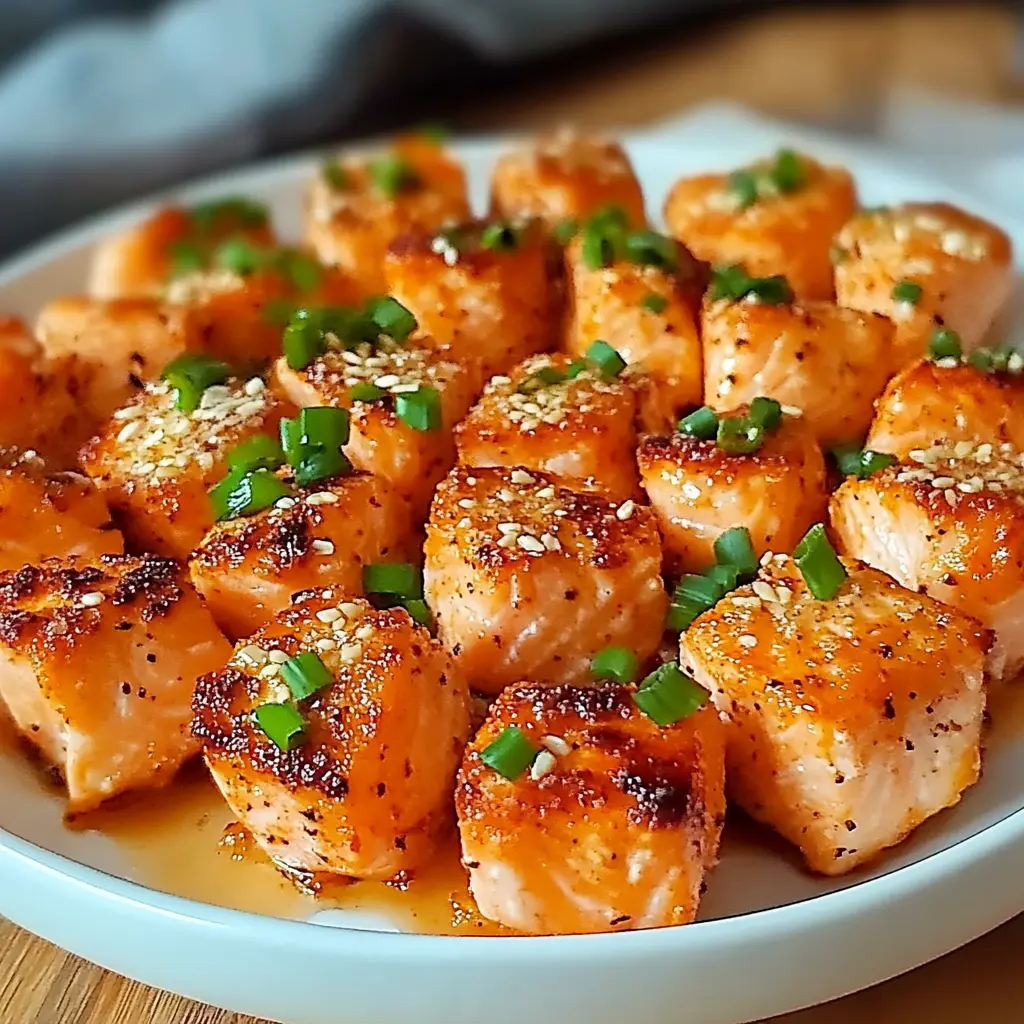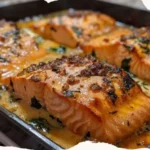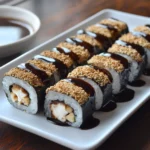Description of this recipe:
These Crispy Spicy Salmon Bites are a flavor explosion in every bite! Tender, flaky salmon is coated in a crispy, seasoned batter and then drenched in a sweet and spicy sauce. They’re incredibly easy to make, perfect as an appetizer, a light meal, or even as a topping for rice bowls or salads. The combination of textures and flavors—crispy, tender, sweet, spicy, and savory—makes these salmon bites irresistible. Get ready for a new favorite way to enjoy salmon!
Why you will love this recipe:
You’ll fall in love with these Crispy Spicy Salmon Bites for so many reasons:
- Quick and Easy: From start to finish, this recipe takes less than 30 minutes to prepare, making it perfect for busy weeknights.
- Flavorful: The balance of sweet, spicy, and savory flavors is addictive. The crispy coating provides a satisfying crunch, while the salmon remains tender and moist.
- Versatile: These bites can be served as an appetizer, a main course, or added to other dishes. They are fantastic served over rice, in lettuce wraps, or even in tacos.
- Healthy: Salmon is packed with omega-3 fatty acids and protein, making these bites a relatively healthy treat.
- Customizable: Easily adjust the spice level to suit your preference by adding more or less cayenne pepper. You can also substitute the sauce ingredients based on what you have on hand.
Introduction
Salmon is a nutritional powerhouse, offering a rich source of omega-3 fatty acids, high-quality protein, and essential vitamins and minerals. While often enjoyed grilled, baked, or pan-seared, this Crispy Spicy Salmon Bites recipe offers a delightful twist on traditional preparations. The crispy coating, achieved with a simple batter, provides a satisfying contrast to the tender, flaky salmon within. The sweet and spicy sauce elevates the dish to another level, creating a harmonious blend of flavors that will tantalize your taste buds.
These bites are perfect for those who are new to cooking salmon or looking for a fun and approachable way to incorporate more fish into their diet. The bite-sized format makes them incredibly versatile and appealing to both kids and adults. This recipe is not just about the delicious flavors; it’s about creating a memorable culinary experience that’s both satisfying and easy to replicate.
Ingredients:
- 1 lb salmon fillets, skin removed, cut into 1-inch cubes
- 1/2 cup all-purpose flour (or gluten-free flour blend)
- 1/4 cup cornstarch
- 1 teaspoon garlic powder
- 1 teaspoon paprika
- 1/2 teaspoon cayenne pepper (adjust to taste)
- Salt and freshly ground black pepper to taste
- 1/2 cup cold water (or more, as needed)
- 1 tablespoon soy sauce (or tamari for gluten-free)
- 1 tablespoon rice vinegar
- 2 tablespoons sriracha sauce (adjust to taste)
- 1 tablespoon honey
- 2 tablespoons sesame oil (or vegetable oil)
- 2 green onions, thinly sliced, for garnish
- 1 tablespoon sesame seeds, for garnish (optional)
Preparation:
Step 1: Prepare the Salmon
Begin by carefully removing the skin from the salmon fillets. A sharp knife makes this process easier. Place the salmon skin-side down on a cutting board and gently slide the knife between the skin and the flesh. Once the skin is removed, cut the salmon into approximately 1-inch cubes. These bite-sized pieces will cook quickly and evenly. Pat the salmon cubes dry with paper towels to remove excess moisture, which will help the batter adhere better.
Step 2: Make the Crispy Batter
In a medium-sized bowl, whisk together the all-purpose flour (or gluten-free alternative), cornstarch, garlic powder, paprika, cayenne pepper, salt, and freshly ground black pepper. The cornstarch is crucial for creating a light and crispy coating. Gradually add the cold water to the dry ingredients, whisking continuously until a smooth, thick batter forms. The batter should be thick enough to coat the salmon pieces evenly but thin enough to drip off slightly. If the batter is too thick, add a tablespoon of water at a time until the desired consistency is reached.
Step 3: Prepare the Spicy Sauce
In a small bowl, whisk together the soy sauce (or tamari), rice vinegar, sriracha sauce, and honey. Adjust the amount of sriracha according to your spice preference. The soy sauce provides a savory umami flavor, while the rice vinegar adds a touch of acidity. The honey balances the spice from the sriracha, creating a sweet and spicy profile. Taste the sauce and adjust the ingredients to your liking. You can add a dash of sesame oil for extra flavor if desired.
Step 4: Fry the Salmon Bites
Heat the sesame oil (or vegetable oil) in a large skillet over medium-high heat. The oil should be hot enough to sizzle when a drop of batter is added. Ensure the skillet is large enough to accommodate the salmon bites without overcrowding, as overcrowding can lower the oil temperature and result in soggy bites.
Step 5: Cook the Salmon
Dip each salmon cube into the prepared batter, ensuring it is fully coated. Use a fork or tongs to gently lift the battered salmon and carefully place it into the hot oil. Fry the salmon bites in batches to avoid overcrowding the skillet. Cook for approximately 3-4 minutes per side, or until golden brown and crispy. The salmon should be cooked through and flaky. Remove the cooked salmon bites from the skillet and place them on a plate lined with paper towels to drain excess oil.
Step 6: Sauce and Garnish
Transfer the crispy salmon bites to a clean bowl. Drizzle the spicy sauce over the bites and gently toss to coat them evenly. Ensure each bite is well-coated with the flavorful sauce. Garnish the salmon bites with thinly sliced green onions and sesame seeds for added flavor and visual appeal. Serve immediately for the best texture and flavor.
COOKING Rating:
- Ease of Preparation: Intermediate
- Flavor Complexity: Medium
- Overall Enjoyment: High
Serving Suggestions:
These Crispy Spicy Salmon Bites are incredibly versatile and can be served in a variety of ways:
- Appetizer: Serve them on a platter as an appetizer for parties or gatherings.
- Main Course: Serve over a bed of steamed rice or quinoa with a side of steamed vegetables.
- Lettuce Wraps: Spoon the salmon bites into lettuce cups for a light and refreshing meal.
- Tacos: Use the salmon bites as a filling for tacos, topped with shredded cabbage, avocado, and a drizzle of lime juice.
- Salads: Add the salmon bites to salads for a protein-packed and flavorful addition.
- Bowls: Add the salmon bites to your favorite poke bowls.
Tips:
- Ensure the oil is hot: The oil temperature is crucial for achieving crispy salmon bites. If the oil is not hot enough, the batter will absorb too much oil and become soggy.
- Don’t overcrowd the skillet: Frying the salmon bites in batches prevents the oil temperature from dropping and ensures even cooking and crispiness.
- Pat the salmon dry: Removing excess moisture from the salmon helps the batter adhere better and prevents splattering during frying.
- Adjust the spice level: Customize the amount of cayenne pepper and sriracha sauce to suit your spice preference.
- Make the sauce ahead of time: The spicy sauce can be made ahead of time and stored in the refrigerator for up to a week.
- Use fresh salmon: For the best flavor and texture, use fresh, high-quality salmon.
- Don’t overcook the salmon: Overcooked salmon will be dry and tough. Cook the salmon until it is just cooked through and flaky.
Prep Time: 15 minutes
Cook Time: 15 minutes
Total Time: 30 minutes
Nutritional Information:
(Estimated values per serving, will vary based on specific ingredients and portion sizes)
- Calories: 350
- Protein: 25g
- Sodium: 500mg
Conclusion
These Crispy Spicy Salmon Bites are a delightful and versatile dish that’s perfect for any occasion. The crispy texture, combined with the sweet and spicy sauce, creates a flavor explosion that will leave you wanting more. Whether you’re looking for a quick and easy weeknight meal or a crowd-pleasing appetizer, this recipe is sure to impress. So, gather your ingredients, fire up your skillet, and get ready to enjoy these irresistible salmon bites!
Questions and Answers about the Recipe:
Q1: Can I use frozen salmon for this recipe?
A: Yes, you can use frozen salmon, but make sure to thaw it completely before cooking. Place the frozen salmon in the refrigerator overnight or use the cold-water thawing method. Pat the thawed salmon dry with paper towels to remove excess moisture before cutting it into cubes.
Q2: I don’t have rice vinegar. What can I substitute?
A: If you don’t have rice vinegar, you can substitute it with white vinegar or apple cider vinegar. Use the same amount as specified in the recipe. Keep in mind that the flavor profile may be slightly different, but it will still work well in the sauce. Lime juice can also be used for a similar level of acidity and it adds a nice citrus brightness.
Q3: Can I bake the salmon bites instead of frying them?
A: Yes, you can bake the salmon bites for a healthier alternative. Preheat your oven to 400°F (200°C). Place the battered salmon bites on a baking sheet lined with parchment paper. Spray the salmon bites with cooking spray to help them crisp up. Bake for 12-15 minutes, or until golden brown and cooked through. While they won’t be as crispy as fried, they will still be delicious.
Q4: How do I store leftover salmon bites?
A: Store leftover salmon bites in an airtight container in the refrigerator for up to 2 days. Reheat them in a skillet over medium heat or in the oven at 350°F (175°C) for 5-10 minutes, or until heated through. Keep in mind that the coating may not be as crispy after reheating. Air frying can also work well for reheating these bites.
Q5: Can I make the batter and sauce ahead of time?
A: Yes, you can prepare the batter and spicy sauce ahead of time. The batter can be made up to a few hours in advance and stored in the refrigerator. The spicy sauce can be made up to a week in advance and stored in an airtight container in the refrigerator. Just whisk or stir both before using. Do not batter the salmon too far in advance of cooking as the batter can become soggy.




